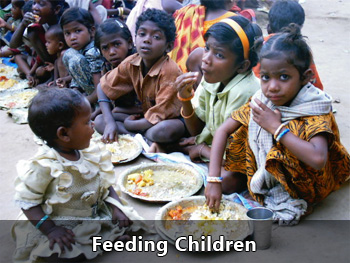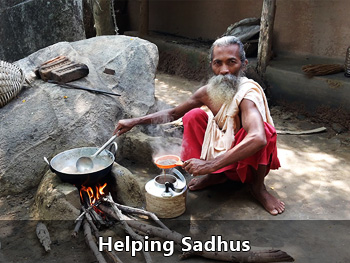On May 22nd, we began the installation ceremony (pranapratishta) of the lifesize deities of Sri Jagannatha, Subhadra and Balabhadra at our ashram in Bhadrak, Orissa. The pranapratishta ceremony was conducted by priests from the Puri Jagannatha temple, headed by Sri Nanda Sharma, and lasted for three days.
On the first day, akhanda nama kirtan was inaugurated, and devotees went in procession to the Salandi river to collect holy water for the Kalashas and for the abhisheka of the deities. Five hundred years ago, Sri Chaitanya Mahaprabhu visited Bhadrak and took bath at the same spot where the devotees collected the water from. As such, this water is very sacred to Gaudiya Vaishnavas.
The installation was done according to the Puri pantha, where the Lord is seen to perform the lilas of being “born” and then “dying” every 12 years in the navakalevara festival. Every detail of the birth ceremony is performed for Lord Jagannatha, including the tying of the umbilical cord and the burying of the embryonic sack. In Puri there are even specific families who will shave their head and perform the shraddha ceremony for Lord Jagannatha so that “he can attain Vaikuntha”. For some it is difficult to understand this complex relationship in light of philosophical expositions on the Lord. This mysterious relationship is actually based on complete personal love for the Lord, not on ignorance of His supreme eternal position. Even the great acharya Sripada Ramanuja was forbidden by Lord Jagannatha to change the system of worship in Puri.
As per the tradition, the Lord was first invoked in a “delivery room” for His birth. The birth of the Lord occurred on ekadashi day, the 23rd of May, at which time devotees were allowed a brief darshan of the Lord without ornaments or alankaras, having just been born with no clothes. Following His birth, the priests were to bath Him with pancha gavya and panchamrita. Just as the doors were opening for the devotees to have their first glimpse of Lord Jagannatha at His birth, rain began to pour down. It created a very nice atmosphere with the rain hitting the roof, and the sound reverberating inside. Later the head priest explained that according to the pratishta viddhi, Indra and the Devas should first bathe the Lord by showering rain, and only after this should the priests bathe the Lord. He said out of hundreds of installations he had conducted (himself being over 80 years old), it was extremely rare and auspicious for the rain to start at the precise time that it was supposed to.
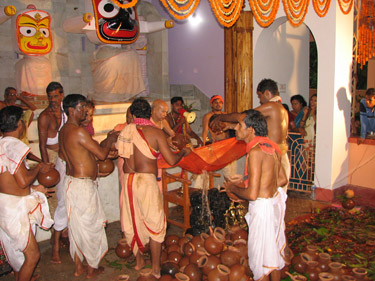
Following the birth of Lord Jagannatha, the deities were bathed with holy water and sacred substances from the cow (ghee, yoghurt, milk, etc.) from 108 Kalashas. As the abhisheka began, a rare bird came inside the altar and landed just inches above Balarama’s head. He sat there the entire abhisheka (around half an hour) just staring at the deities being bathed. This particular bird is famous for staying in the Jagannatha temple in Puri.
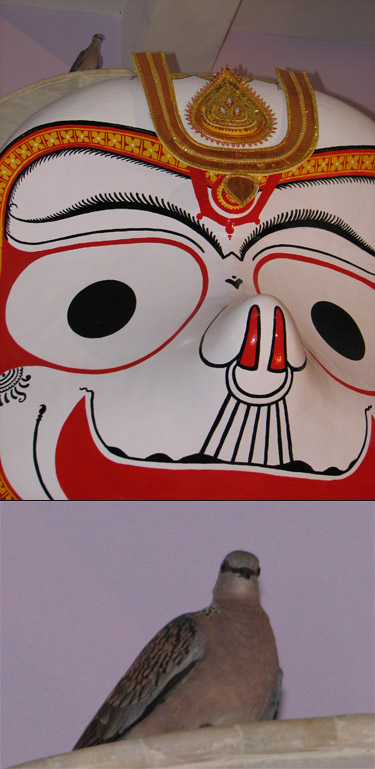
After the abhisheka, the priests wanted to close the altar, but the bird was refusing to leave. Finally after failing to get the bird to come out, the priests decided the bird should spend the night on the altar with Lord Jagannatha. The next morning, when the priests opened the door to offer naivedyam to the Lord, the bird immediately flew out on its own, never to be seen again.
From the time that Lord Jagannatha arrived at our ashram last year, many auspicious signs have been observed. The day after the deities arrived in Bhadrak, a large white cobra around 7 feet in length was seen next to the temple where the deities were staying, and in subsequent days two other cobras were seen around the same area. In 20 years we have never found cobras in this area, but due to the arrival of the Lord, the Nagas came for the Lord’s darshan. Within the first month of the deities arriving, many sacred trees spontaneously started growing around the temple, even though they were not growing anywhere nearby. One Peepal tree, three Banyan trees, three Kadamba trees, two Bilva trees, three Champaka trees and many Neem trees sprouted up around the temple, and are now all growing between 10 to 15 feet tall. The Kadamba tree is especially associated with Lord Krishna, as He was very fond of playing with the flowers of this tree, which resemble large round balls. The Peepal tree is worshipped throughout India, and in the Gita Lord Krishna states, ashvatthah sarva-vrikshanam, “Amongst all trees, I am the Peepal tree (ashvattha)”. In Puri Jagannatha temple there is a Peepal tree that is considered a Kalpa Vriksha.
Early in the morning on the 24th, the head priest, Sri Nanda Sharma, entered the garbhagriha, along with one assistant, to perform gupta mantra japa, the final rituals for the pranapratishta. While chanting the mantras, twice he fainted. When he came back to consciousness he told the other priest that he had seen a huge effulgence around Jagannatha and lost consciousness. Though he is over 80 years old, for the entire three days he went without eating any food, only absorbed in mantra japa and the pratishta rituals.
On the 24th the Lord prepared to offer His first alankara darshana to His devotees. Over the previous two days, the devotees were only able to view the Lord for 30 minutes during His birth and abhisheka, so they were very anxious to see the Lord. Finally at 4 pm, following the completion of all the installation rituals and purnahuti, the Lord was dressed in Badashringar Vesha, and garlanded with lotus malas consisting of over 2,000 lotuses.



The doors opened with all the devotees singing and dancing, filled with joy to finally be able to see the Lord. The auspicious sounds of conchshells, drums and bells filled the air, along with the chanting of the devotees.
Every evening there was Bhagavat Katha by sannyasis from ISKCON and Gaudiya Matha, followed by bhajans by the two most famous singers in Orissa, Pankaj Jha and Kumar Bapi.

Puri Pandas sitting with Lord Jagannatha

Devotees having the first darshan of Lord Jagannatha



Sri Bhakti Sundar Sagar Swami and Sri Subhag
Swami having the first darshana of Lord Jagannatha.

Installation and worship of Lord Jagannatha’s
mirror by head priest Sri Nanda Sharma.

Sri Man Mohan Samal, Revenue and Supply Minister of
Orissa Government has darshan of Lord Jagannatha


Sri Subhag Swami (ISKCON) and Sri Bhakti
Sundar Sagar Swami (Udala Gaudiya Matha)
perform abhisheka of utsava murtis.



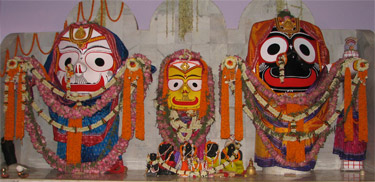

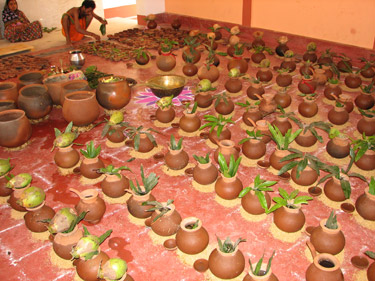
Preparing 108 Kalashas for abhisheka of utsava murtis.

Procession to collect holy water from Salandi river.
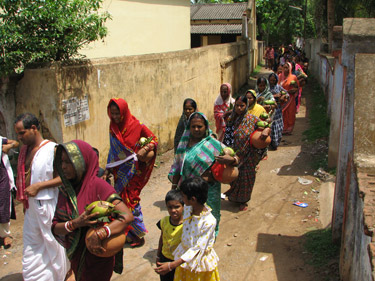



Devotees fill the Kalashas with sacred water.


Puja is performed to the Kalashas
before the return journey.
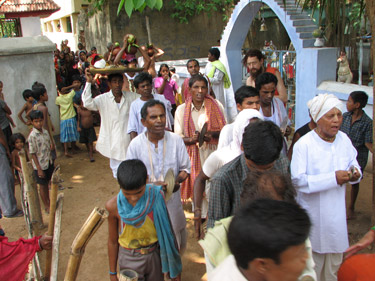

Sri Bhakti Sundar Sagar Swami giving Bhagavat Katha.



Sri Subhag Swami speaking from Bhagavad Gita.

Sri Pankaj Jha, Orissa’s most famous singer,
sings Bhajans for Lord Jagannatha.


After performing, Sri Pankaj Jha offers obeisances
to Lord Jagannatha. Balabhadra dropped a lotus
for him as he offered obeisances.

Kumar Bapi, Orissa’s hit singer, chants Hare Krishna.









Continuous distribution of prasadam to all visitors.






Receive our daily email newsletter on Hinduism, Yoga, Meditation, Ayurveda and Natural Healing.

